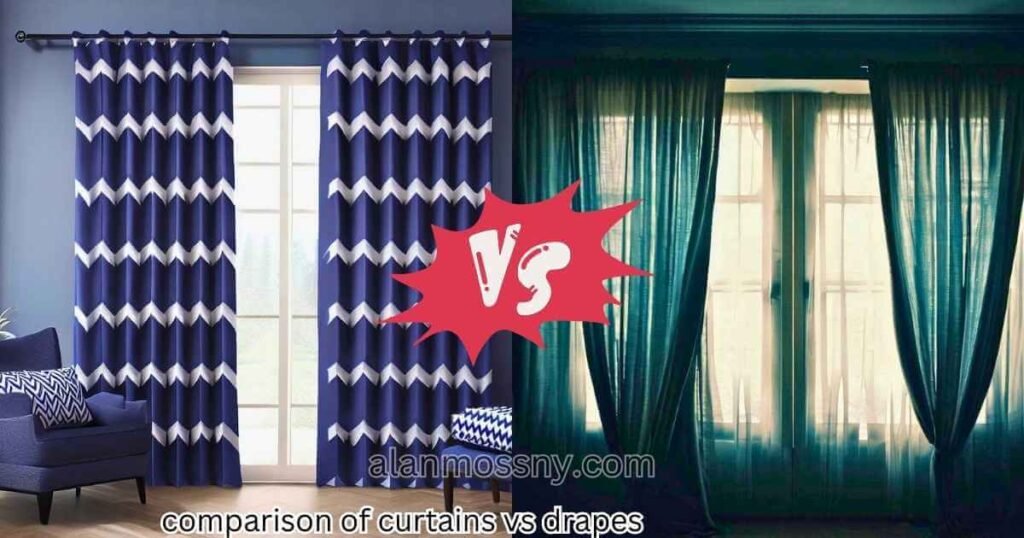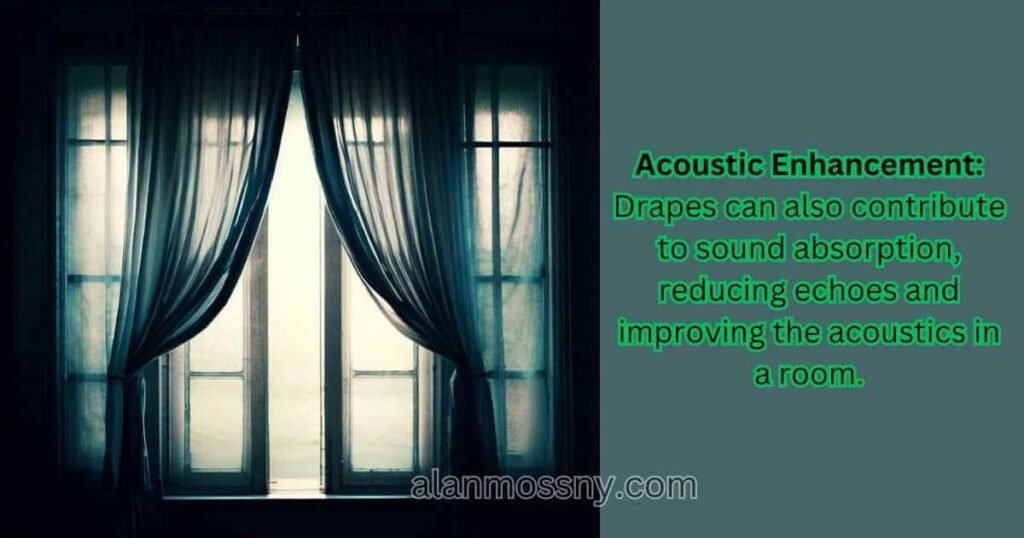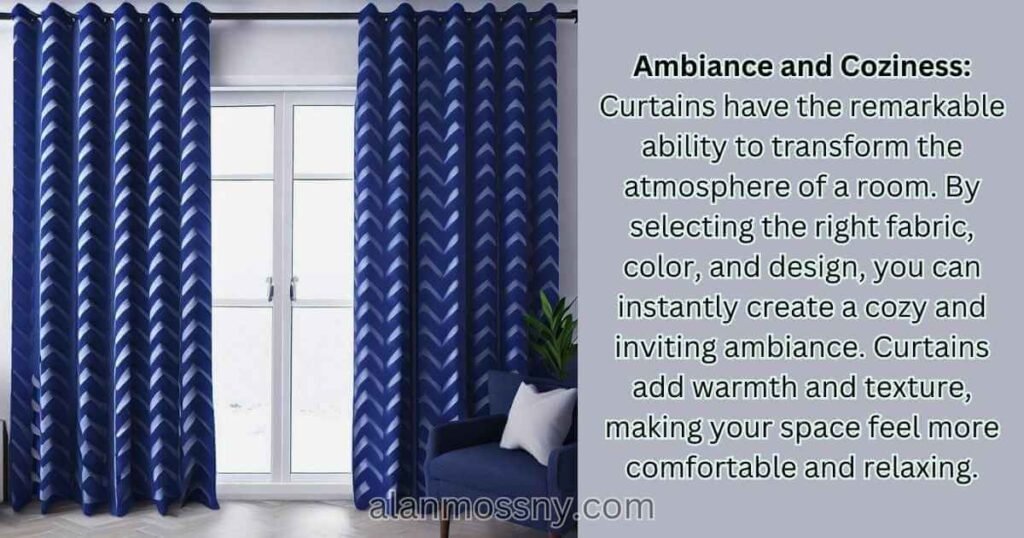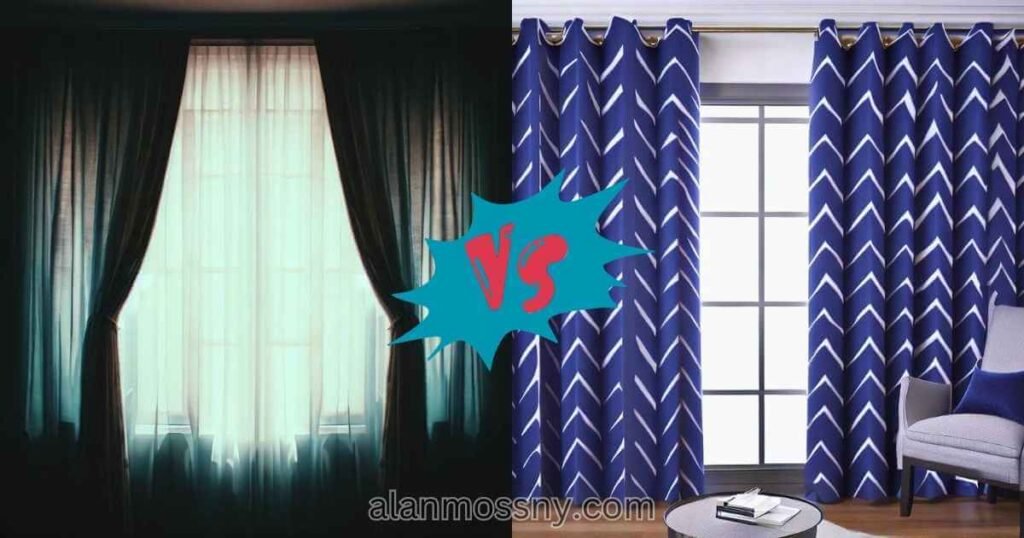Curtains vs Drapes: Choosing the Perfect Window Dressing
Curtains vs drapes: They are similar items used for window coverings but there are some key differences. Curtains are lightweight- sheer or semi-sheer fabric panels- often made from cotton or linen- that filter light and provide privacy.
They are typically used in small rooms or for decorative purposes. On the other hand- Drapes are made from heavier fabrics like velvet or brocade and are lined to block light and provide insulation. They are often floor-length and used in larger rooms or for more formal settings.

Curtains are light and sheer- while drapes are heavy and opaque. When deciding between the two- consider the desired level of light control + privacy and the overall aesthetic you want for your space.
Choosing the Right Curtains vs. Drapes for Your Decor
When it comes to decorating your home🏡 one of the most important aspects to consider is the window treatment. Curtains and drapes are two popular options that can significantly impact the overall style and atmosphere of a room. Understanding the differences between curtains vs drapes – as well as considering various factors can help you make an informed decision.
Let’s explore the main factors that you should consider when picking the ideal window treatment for your décor.
Factors to Consider When Choosing Between Curtains vs. Drapes
Creating a cohesive style is crucial to ensure that your window treatment seamlessly integrates with the overall decor of your space. Here are a few factors to keep in mind:
- Color: Selecting curtains or drapes that complement or enhance the room’s color scheme is essential. Consider whether you want your window treatment to blend in or make a bold statement.
- Pattern and texture: Different patterns and textures can add depth and eye-catching appeal to your windows. Be mindful of the existing patterns or textures in the room and choose window treatments that complement or contrast them.
- Length and fullness: The length and fullness of your curtains or drapes can greatly impact the overall aesthetic. Decide whether you prefer a more tailored look or a dramatic 🎭 floor-to-ceiling effect.
- Functionality: Consider the practical function of your window treatment. Do you need curtains or drapes for privacy🤫- light control and insulation or all of the above? Choosing the suitable fabric and thickness can help achieve the desired functionality.
- Style of the room: Consider your room’s overall style. Is it traditional/modern/rustic or eclectic? Ensure your window treatment aligns with the theme and mood of the space.
Determining Your Preference: Curtains vs. Drapes
Having a clear understanding of your personal style preference is essential when selecting curtains or drapes. Consider the following aspects:
- Formal or casual: Determine whether you lean towards a formal or casual style. Curtains typically lend themselves well to a more casual and versatile look🤟🏽- while drapes exude elegance and formality.
- Light filtering or blackout: Decide whether you prefer curtains or drapes that filter natural light or those that darken the room entirely. This choice will depend on the specific needs of each room and your personal preference.
- Fabric choices: Explore different fabric options to find the perfect match for your style. Curtains made from lighter fabrics like linen or cotton convey a breezy and relaxed feel😇 – while drapes crafted from heavier materials like velvet or silk evoke a more luxurious ambiance.
- Hardware and accessories: Consider the hardware and accessories that will complement your curtains or drapes. The choice of curtain rods – tiebacks – and finials can further enhance the overall style and visual appeal.
Now that you’re familiar with the important factors to consider🎭 – take some time to reflect on your personal style preference and the overall design of your room. By carefully selecting the right window treatment- you can effortlessly elevate your decor and create a cohesive look that reflects your individual taste and style.
Evaluating The Practical Benefits Of Curtains Vs Drapes
When it comes to enhancing the aesthetics of a room and providing functional benefits- curtains and drapes play a crucial role. While both options offer advantages☺️- it’s essential to evaluate their practical benefits to determine the better choice for your needs.
In this section, we will explore three key factors for comparison: light control and privacy insulation + energy efficiency and sound absorption 🤫 + noise reduction.

Light Control And Privacy
- Curtains:
- Curtain panels consist of lightweight fabrics that allow varying degrees of light filtration.
- They come in a wide range of opacity levels- from sheer to blackout – offering flexibility in controlling natural light.
- While curtains provide privacy during the day – they may not be as effective at night when the lights are on.
- Drapes:
- Drapes are crafted from heavier fabrics – such as velvet – silk or thermal-lined materials – ensuring superior light blockage.
- With their thicker layers; drapes offer more privacy 🤫- making them ideal for rooms that require complete darkness and seclusion.
- The heavyweight materials of drapes also help prevent light penetration from the outside – ensuring privacy even at night.
Insulation And Energy Efficiency: Curtains Vs Drapes
- Curtains:
- Depending on the fabric thickness- curtains can provide a moderate level of insulation.
- They contribute to maintaining room temperature by reducing heat transfer through windows- which can enhance energy efficiency.
- Thick-lined curtains offer better insulation – but their effectiveness may be limited during extreme weather conditions.
- Drapes:
- Drapes excel in insulation and energy efficiency due to their heavy and often lined construction.
- The multiple layers of thick fabric provide a substantial barrier against heat loss in winter and heat gain in summer.
- By preventing drafts and air leakage- drapes significantly reduce energy consumption- resulting in potential cost savings.
Sound Absorption And Noise Reduction: Curtains Vs Drapes
- Curtains:
- While curtains can provide minimal sound absorption due to their lightweight nature- they have limited effectiveness in noise reduction.
- Thicker and lined curtains can slightly dampen external noise but may not entirely eliminate it.
- They are more suitable for reducing echoes and enhancing acoustics within a room.
- Drapes:
- Drapes offer excellent sound absorption and noise reduction properties with their dense and heavy materials.
- Drapes can absorb sound waves- reducing echo and external noise intrusion more effectively than curtains.
- They are often recommended for rooms requiring high noise insulation- such as bedrooms- home theaters or study areas.
When evaluating the practical benefits of curtains vs drapes; consider their varying levels of light control and privacy – insulation and energy efficiency 🟢 and sound absorption and noise reduction. Both options have their advantages and suitability for different settings and preferences.
Understanding these differences can help you make a well-informed decision and enhance the functionality and ambiance of your space.
Curtains vs. Drapes: A Comprehensive Exploration of Materials and Fabrics
When it comes to choosing the right window treatment for your space🏡 the materials and fabrics you select play a crucial role in achieving the desired look and functionality. Curtains and drapes offer a wide range of options 🤔 from natural fabrics to synthetic ones- each with their own pros and cons.
Let’s delve into the different materials and fabrics available for window treatments to help you make an informed decision.
Natural Fabrics: Pros And Cons
Natural fabrics are a popular choice for curtains and drapes due to their organic appeal and timeless elegance. However, they do come with their own set of advantages and disadvantages. Here are the key points to consider:
Cotton:
- Pros:
- Soft and breathable fabric- allowing air to circulate freely.
- Versatile and widely available in various patterns and colors.
- Easy to care for and maintain.
- Cons:
- Can shrink if not pre-washed or improperly cared for.
- It may fade periodically when exposed to direct sunlight for extended periods of time.
- Prone to wrinkling- requiring regular ironing or steaming.
Linen:
- Pros:
- Offers a natural – relaxed and textural look.
- Highly durable and long-lasting.
- Provides excellent light filtration while maintaining privacy.
- Cons:
- Wrinkles easily- requiring regular ironing or steaming.
- Limited color options compared to other fabrics.
- Can be more expensive than other natural fabrics.
Silk:
- Pros:
- Exudes luxury and elegance – adding a touch of sophistication to any room.
- Drapes beautifully and provides a luxurious sheen.
- Offers good insulation and light-filtering properties.
- Cons:
- Vulnerable to sun damage and fading.
- Requires professional cleaning to maintain its luster.
- It is expensive compared to other natural fabrics.

Synthetic Fabrics: Pros And Cons
Synthetic fabrics have gained popularity in recent years due to their durability – affordability and wide variety of designs. However, it’s essential to evaluate their pros and cons before making a decision. Here’s what you need to know:
Polyester:
- Pros:
- It is highly resistant to any kind of fading and wrinkling, making it low-maintenance.
- It Offers many different colors – patterns and textures.
- Affordability makes it a budget-friendly option.
- Cons:
- Can feel less breathable compared to natural fabrics.
- May retain static electricity and attract dust.
- Not as luxurious or sheen as natural fabrics.
Acrylic:
- Pros:
- Resistant to sunlight and fading.
- Lightweight and easy to handle.
- Provides insulation and noise reduction properties.
- Cons:
- Prone to pilling or fuzzing with frequent use.
- It may not offer the same level of elegance as natural fabrics.
- Limited color options compared to other materials.
Nylon:
- Pros:
- Exceptionally durable and long-lasting.
- Offers excellent resistance to wear and tear.
- Offer many different color options and patterns.
- Cons:
- It can be prone to static electricity and attract dust.
- Not as soft or luxurious as natural fabrics.
- Requires proper care to prevent wrinkling.
Selecting the suitable material and fabric for your curtains or drapes depends on your desired aesthetic – budget🤑 and lifestyle. Consider the pros and cons of natural fabrics and synthetic fabrics to find the perfect window treatment that suits your needs. Remember to consider factors like sunlight exposure – desired level of privacy and maintenance requirements – ensuring your chosen fabric enhances your space’s functionality and beauty.

Cleaning And Maintenance Requirements: Curtains Vs Drapes
Curtains vs drapes are both popular choices for window coverings- each offering their own set of advantages and aesthetics. However, when it comes to cleaning and maintenance – there are some key differences to consider. In this section, we will explore the care instructions for curtains and drapes – helping you make a will-informed decision based on your lifestyle and preferences.
Care Instructions For Curtains:
- Regular washing: Curtains made from fabrics such as cotton or polyester can typically be machine-washed on a gentle cycle. It is recommended to use a mild detergent and cold water to prevent any damage or shrinkage.
- Dry cleaning: Dry cleaning may be the safer option for delicate or heavily embellished curtains. Professional dry cleaners have the necessary expertise to handle intricate designs without causing any harm to the fabric or decorative elements.
- Ironing: To remove any wrinkles or creases – curtains can be ironed using a low setting or steamed. It is crucial to check the fabric’s ironing instructions beforehand – as certain materials may be sensitive to heat.
- Maintenance tips: Regularly dusting or vacuuming curtains can help keep them clean and debris-free. It is recommended to use a soft brush attachment to avoid damaging the fabric. Also, spot cleaning with mild detergent and gentle blotting can tackle any localized stains.

Care Instructions For Drapes:
- Professional cleaning: Due to their heavier and often more luxurious fabrics- drapes often require professional cleaning. Dry cleaning is commonly recommended to maintain their delicate appearance and prevent any potential damage.
- Dusting and vacuuming: Similar to curtains – regular dusting and vacuuming can help keep drapes clean. However, using a low suction setting and soft brush attachment is crucial to prevent any fabric snagging or tearing.
- Sunlight exposure: Drapes can fade over time when exposed to direct sunlight. To prevent this – consider using lining or interlining to protect the fabric from UV rays. Alternatively, rotating or using sheer curtains during peak sunlight hours can help preserve their colors.
- Maintenance tips: Avoid pulling or tugging on drapes excessively ☺️ as this may lead to weakened seams or fabric tearing. If any spills occur 😱- immediate spot cleaning with a mild detergent and gentle blotting is recommended.
Remember, the cleaning and maintenance requirements for curtains and drapes may vary depending on the specific fabric – design and manufacturer’s instructions. Always refer to the care label or consult a professional for the best results. By following these care instructions – your curtains or drapes can stay in top condition for years to come.

Comparing The Cost Factors Between Curtains And Drapes
Upfront Cost Comparison: Curtains Vs Drapes
When it comes to deciding between curtains vs drapes – one of the key factors to consider is the cost. Here, we will compare the upfront costs associated with both options:
Curtains:
- Ready-made curtains can be found relatively cheap – making them a budget-friendly choice.
- The price of curtains can vary depending on the material used – with options ranging from affordable synthetic fabrics to luxurious silk or velvet.
- Custom-made curtains – tailored to fit your specific window measurements – may come at a higher cost compared to ready-made options.
- Curtain rods or tracks needed for hanging the curtains will incur an additional expense – though they are generally affordable.

Drapes:
- Drapes are often more expensive than curtains due to their heavier weight and higher-quality materials.
- The cost of drapes is highly influenced by the type of fabric chosen – including options like silk – linen or premium blends.
- Custom-made drapes designed to fit your window precisely – are typically more expensive than off-the-shelf options.
- Investing in drapes also requires purchasing appropriate hardware such as rods/hooks/rings – which can increase the overall costs.
Long-Term Cost Analysis: Curtains Vs Drapes
Apart from the upfront expenses – considering the long-term costs is vital when deciding on curtains or drapes for your space:
Curtains:
- Since curtains are generally lightweight and less substantial than drapes – they are typically easier to maintain and clean.
- Curtains can be machine washed or dry cleaned – depending on the fabric- saving on laundry expenses in the long run.
- However, certain delicate or high-end curtain materials may require professional cleaning- adding to the maintenance costs.
- Durability varies among curtain fabrics and less expensive options might need replacement sooner than pricier and more resilient ones.
Drapes:
- As drapes are heavier and usually made from premium materials😇 – they are more resistant to wear and tear 🟢 lasting for several years.
- Unlike curtains, drapes often require professional dry cleaning – resulting in higher long-term maintenance expenses.
- The heavy weight and thickness of drapes provide additional insulation leading- to improved energy efficiency and potential savings on heating and cooling bills.
- Investing in high-quality drapes might be more costly initially- but their durability and beautiful properties can produce long-term benefits.
Now that we have explored the cost factors between curtains vs drapes – you have a better understanding of the budget considerations related to each option. Consider your preferences- budget 💸 and long-term goals to make an informed choice that is suitable for your needs and enhances the aesthetics of your space.
Exploring Customization Opportunities And Specialty Features
When it comes to choosing window treatments – customization opportunities and specialty features can make all the difference in creating a polished and personalized -look for your home. In this section, we will explore the world of curtains vs drapes – highlighting the custom design and fit options as well as the specialty features and add-ons available for both.

Custom Design And Fit: Curtains Vs Drapes
- Made-to-measure: Curtains and drapes can be custom-made to fit your specific window dimensions – ensuring a perfect fit and a tailored appearance.
- Endless fabric choices: With customization – you have some chance to select from a variety range of brands- fabrics – colors and patterns that suit your style and complement your existing décor.
- Personalized styles: Whether you prefer a classic pinch pleat / a modern grommet top or a sophisticated swag and jabot – custom curtains and drapes allow you to choose the style that best reflects your taste and enhances the overall ambiance of your space.
- Lining Options: Custom window treatments often offer a choice of lining materials – such as blackout / thermal or sheer linings; allowing you to control privacy🤫 light filtration and energy efficiency 🟢.
- Unique trims and embellishments: Add a touch of elegance and uniqueness to your curtains or drapes by incorporating trims – tassels or fringe in coordinated or contrasting colors – giving your window treatments a personalized flair.
Specialty Features And Add-Ons: Curtains Vs Drapes
- Motorization: Are you tired of dealing with cords and manual operation? Opt for motorized curtains or drapes that can be easily opened and closed with a simple touch of a button or a voice command – providing convenience and ease of use.
- Remote control: Extend your control over your window treatments with remote-controlled curtains or drapes; allowing you to adjust them from anywhere in the room without having to physically handle them.
- Smart home integration: Integrate your curtains or drapes with a smart home system to automate their operation based on preset schedules/ sensor inputs or voice commands – offering a seamless and intelligent solution for enhancing your home’s functionality.
- Insulation and energy efficiency: Some specialized curtain and drape options come with added insulation properties – helping to regulate room temperature – minimize heat loss and reduce energy consumption – will help create a more sustainable and eco-friendly living environment.
- Soundproofing: If noise disturbances are a concern; consider curtains or drapes with soundproofing features. These specially designed window treatments absorb sound waves – providing a quieter and more peaceful atmosphere.
With custom design and fit options as well as specialty features and add-ons available for both curtains and drapes – you have the flexibility to create the perfect window treatments that not only enhance the aesthetics of your space but also cater to your specific needs and preferences.

So, let your imagination run wild and explore all the ways you can transform your windows into stunning focal points of your home.
Frequently Asked Questions Of Curtains Vs Drapes
What Is The Difference Between Curtains And Drapes?
Curtains are lightweight and sheer, while drapes are heavier and made of thick fabric for better light control and insulation.
Which Is Better For Privacy: Curtains Or Drapes?
Drapes offer better privacy due to their heavy fabric and ability to effectively block out light and outside view.
Do Curtains And Drapes Serve The Same Purpose?
Yes, both curtains and drapes enhance the aesthetic appeal of a room and control light and privacy.
Can Curtains And Drapes Be Used Together?
Absolutely! Combining curtains and drapes can create a layered look, adding depth and texture to your window treatments.
Are Curtains Or Drapes More Suitable For Different Room Styles?
Curtains are versatile and can complement various room styles. At the same time, drapes are often chosen for a more formal and elegant aesthetic.
Conclusion Of Curtains Vs Drapes
The debate between curtains vs drapes ultimately comes down to ones personal preference and the specific needs of each individual. Both curtains and drapes offer their own unique advantages. They can be used to enhance the overall aesthetics of any room.
Curtains are versatile and come in a wide range of colors and different patterns – making them an ideal choice for adding a gentle- modern touch of style to any window. On the other hand, drapes are more luxurious and offer better light control and insulation.
They are commonly used in formal settings or for rooms that require enhanced privacy and darkness. Ultimately, it is important to consider factors such as the level of light control – privacy – maintenance and design preferences when deciding between curtains vs drapes.
By carefully evaluating your personal and family members needs and selecting the proper window treatment – you can create a perfect ambiance and transform any space into a beautiful haven.
Stay connected with us on social media for the latest updates and more valuable content.
